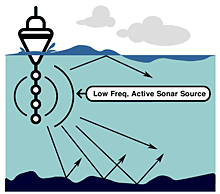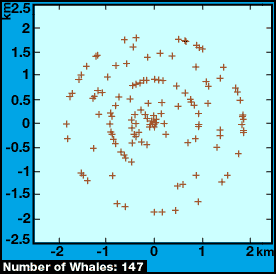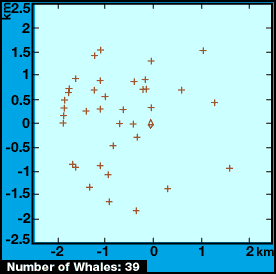
source: cnn 30/06/99
Low-frequency sonar raises whale advocates' hackles
Part I of a three-part series
By Stephanie Siegel CNN Interactive Copy Editor
"Our whales didn't come back this year," said Capt. "China Mike" Yee, easing the Lana Kila tour boat along Hawaii's aquamarine Kona coast. "Not since the Navy did their sonar testing here."
The Navy disputes his assessment, saying this year's humpback whale season was normal, and more whales than ever before were seen in March 1998, when biologists studied humpbacks' response to the Navy's Low-Frequency Active Sonar (LFAS) equipment in Hawaiian waters.
Whales use their ears to get around in the dark depths. Beaming sound into their world is like shining bright lights at us. Scientists don't know what harm, if any, it may do.
The Natural Resources Defense Council, which released its "Sounding the Depths" report Monday, pushed the Navy to find out before putting the new submarine-detection system to work.
The first two phases of Navy-funded testing (on blue, finback and gray whales) started in fall 1997 off California. An Environmental Impact Statement based on that and the Hawaii research will be published soon in the Federal Register. The public will have 45 to 60 days to comment.
Meanwhile, the House Subcommittee on Fisheries Conservation, Wildlife and Oceans began hearings Tuesday on the effectiveness of the 1972 Marine Mammal Protection Act to evaluate what changes should be enacted during this year's reauthorization.
And another sonar project is holding four public meetings that began Tuesday in Kauai, Hawaii. The Acoustic Thermometry of Ocean Climate (ATOC) project is asking to extend its two-year permit to operate low-frequency sonar under the water off Kauai another five years.
There will be opposition. Some scientists and environmentalists say the environmental impact studies are so narrow that they are meaningless. And the whales may be in danger.
Humpback whale breeding grounds once could be found in any ocean. For a variety of reasons, including formerly unrestrained whale hunting, now there are three separate, reproductively isolated groups in the Pacific, Atlantic and Southern oceans. All are endangered. Blue, fin and sperm whales are endangered, too. The gray whale's environmental status is "monitored."
The low-frequency lowdown Protesters, who swam near the research vessel trying to stop the Hawaii LFAS tests, doubt the Navy has prepared its Environmental Impact Statement in good faith. After spending more than $200 million on LFA research and development, they say, the Navy is committed to use it.
But Navy program manager Joe Johnson says the Navy would not implement a system if it violated environmental laws. Independent experts from Cornell University and Woods Hole Oceanographic Institution were hired to conduct the research to assure believable results. "These guys are extremely committed to the welfare and well-being of the animals," Johnson said.
 | |
| A 200 decibel sound would fade to 140 decibels at a distance of 1,000 yards, the Navy's research team estimated. It fades more slowly, though, when it bounces off the ocean bottom or surface or off the sides of one of the natural "sound channels" in the oceans. | |
Military, commercial, even recreational boats active sonars ping every nine to 15 seconds, sounding the depths. They already create noise pollution in lakes, ports and shipping lanes.
Low-frequency sound (below 1,000 hertz) goes farther. You may not be able to hear the singers on your neighbor's stereo, but you can hear the bass.
ATOC uses the ocean's natural channels to transmit low frequency thousands of kilometers. Sound travels slightly faster in warmer water. Scientists believe that by measuring how fast sound travels across the cooler "Deep Sound Channel" in comparison with its speed in other parts of the ocean, they can detect a global warming trend.
The noise about noise Whales sing low and loud. Their sounds travel thousands of miles. Blue whales off Newfoundland can be heard in Puerto Rico, said Dr. Christopher W. Clark, a principal investigator of both ATOC and LFA's mammal research. Not by humans, whose ears are made for air and who rely more on vision anyway, but by sonar detectors, and presumably by whales.
Whales depend on hearing the way humans depend on sight. They use their sonar to find food, detect enemies, attract mates and know where their children are.
Scientists say low-frequency sonar, if loud enough, has the potential to drown out the whales so they can't hear what they need to. Whales listening intently for the quiet swish of a school of fish may go hungry. A 3-month-old whale who leaves his mother's side to begin to explore his world may not hear her calling to him and may never find her again.
It could do other damage, too.
Very loud sounds can rip ear, lung and other vibrating tissues. A sound wave is a pressure wave; that's why you can sometimes feel your body vibrate during loud, low sounds. When body tissues resonate with the sound's frequency, the pressure increases.
 | |
| The impact of a sonic disturbance varies with the animal's distance from the sound source. | |
Repeated exposure to moderately loud sounds can damage human ears, as rock musicians have learned.
Even milder sounds can be annoying, stressful, distracting (picture the golfer about to swing) or confusing.
Some sounds attract whales toward boats, making them more vulnerable to collision.
Sometimes whales fall silent. Sperm and pilot whales stopped "singing" (using their active sonar) altogether during a 220 decibel test in 1991, some of them for days, which meant they were not eating during that time.
Whales may fall silent to hide from their sharp-eared predators (killer whales, or orcas). Because silence evolved as their survival response, they hush at any strange noise.
When they're not using their active sonar, whales are not courting potential mates, and they may not be finding food. Deep-water whales, the kind with teeth, are thought to use echolocation (active sonar) for navigation and hunting.
Sounds booming at regular intervals also could interfere with whales' sleep. Little is known about how whales and dolphins sleep, except that they must surface to breathe. "In humans, prolonged or repeated noises can cause difficulties in falling asleep, changes in sleep patterns, and awakenings," says the often-cited book "Marine Mammals and Noise" by W. John Richardson et al.
Chronic noise may lead to high blood pressure in humans, and strong noise can affect reproduction and rearing of young in land animals, Richardson's book adds.
Repeated stress can take a toll on an animal's immune system, leaving it more vulnerable to parasites and other infections.
Extreme stress or panic may cause whales to lose their way and wash up on beaches; or their disorientation may result from damage to their hearing or another aspect of their navigational sonar system.
In a 1998 Nature article, Alexandros Frantzis pointed out that 12 Cuvier's beaked whales beached themselves alive on a Mediterranean coast while NATO was testing LFAS there. He concluded the chance of that happening for any other reason was less than 0.07 percent. The U.S. Navy research vessel Alliance performed that test for NATO but at a higher frequency than the United States used, said the Navy's Johnson.


|
Scatterplots from the Hawaii LFA study show the distribution of whales around the ship before and after the test.
|
Ten gray whale calves stranded alive in California in January-February 1998 (during and after LFA tests there), an abnormally high number, said EnviroWatch Inc.
Two dead whales were seen near the Kauai ATOC source in November and December 1997, the Cetacean Society International reported.
Three humpback whales died in northern California in November 1995 within a week after the ATOC equipment was turned on for engineering tests -- before the formal program to monitor mammals began. But the project resumed "following a determination that it was highly unlikely the test transmissions could have been responsible," the Marine Mammal Commission reported.
Whales have altered their migration routes to avoid noise louder than 120 decibels, research has shown.
Whales moved away from the LFA ship during the March 1998 Hawaii tests, but the research team said that was their normal migration pattern. The humpbacks were just heading north and east as other studies have shown they do every March, their preliminary "Quicklook" report said.
Gray whales moved more than a kilometer to avoid a 185-decibel sound source in the California test.
One ATOC bimonthly report counted 1,754 animals when the sonar was off and 138 animals when it was on. Other ATOC reports said sperm whale sightings decreased 90 percent, and humpbacks were seen an average of one to two nautical miles farther away from the sound source when it was on than when it was off. The average distance for all sperm whale groups was greater when the sound was on, but "it does not have a strong causal linkage to acoustics," the scientists reported.
Whales may be in even greater danger when they show no immediate response.
A 1993 report on oil drilling and explosions in the Journal of the Acoustical Society of America found humpback whales with severely damaged ears similar to blast injuries in humans. But the whales had shown only small changes in movements and behavior -- no dramatic reaction to the sound. The authors cautioned that whales' visible short-term reaction to loud sound may not be a valid measure of its impact on them.
"We should be just as concerned about the marine mammal that becomes habituated to the sound and presses on regardless, or that willfully suffers discomfort to remain in prosperous waters," said the Natural Resources Defense Council in its report.